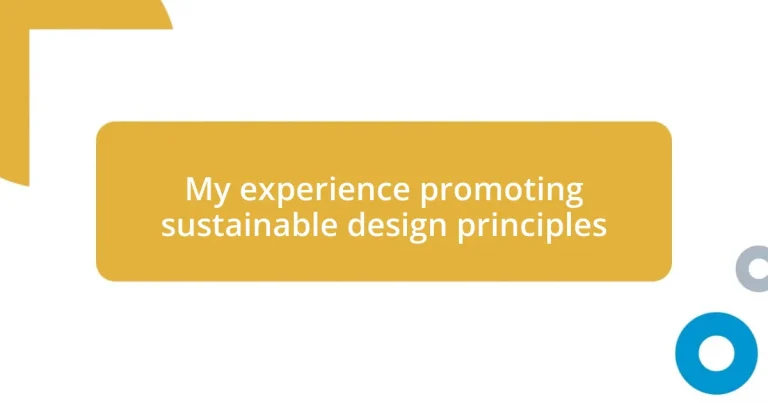Key takeaways:
- Sustainable design principles focus on meeting present needs while preserving resources for future generations, highlighting the importance of thoughtful design for environmental harmony.
- Education, collaboration, and digital visualization are crucial strategies for promoting sustainable design, empowering communities to make informed choices and fostering creative partnerships.
- Effective stakeholder collaboration enhances creativity, increases community buy-in, and ensures long-term sustainability by aligning design with local needs.
- Overcoming resistance to change and budget constraints can be addressed through patience, resourcefulness, and fostering open communication and learning within implementation teams.

Understanding sustainable design principles
Sustainable design principles revolve around creating solutions that meet the needs of the present without compromising future generations. I remember walking through a recently renovated park where they had incorporated native plants, reducing water usage while enhancing local biodiversity. It struck me how crucial thoughtful design can be in fostering environmental harmony.
One of the key aspects of sustainable design is resource efficiency. I often think about the time I visited a construction site where they reused materials from a demolished building. It was eye-opening to see how sustainable practices not only minimized waste but also added a unique character to new structures. Have you ever considered how reusing materials can contribute to a deeper connection with our surroundings?
Moreover, sustainable design encourages the integration of renewable energy sources. I’ve seen projects harnessing solar panels and wind energy that significantly lower carbon footprints. It ignites a sense of hope knowing that these principles are not just theoretical; they’re actively shaping a greener, more resilient world. Isn’t it inspiring to think that our choices in design can lead to a healthier planet?

Strategies for promoting sustainable design
Implementing strategies for promoting sustainable design begins with education. I recall attending a workshop where experts guided us through the nuances of eco-friendly materials. It was enlightening to learn that simple changes, such as opting for sustainable wood or low-VOC paints, could drastically reduce environmental impact. Have you ever thought about how knowledge can empower us to make better choices? It’s like a light bulb moment that motivates action not just for ourselves, but for our communities.
Another effective strategy is collaboration, which I’ve found to be central in many successful projects. I was part of a team that partnered with local artists and architects to create a sustainable urban garden. Collaborating allowed us to blend artistic expression with functional design, demonstrating how diverse perspectives can elevate a project. It reminded me of how important it is to share ideas and strengthen community ties, turning sustainable design into a communal effort. Have you considered how your network can enhance your sustainable initiatives?
Lastly, utilizing digital tools for visualization can significantly influence perceptions of sustainable design. From 3D modeling software to virtual reality tours, I remember the first time I used such tools for a project. It transformed abstract concepts into tangible visuals, making the benefits of sustainability instantly relatable. Engaging presentations can rally support and inspire others to take part. Doesn’t it feel fulfilling to bring ideas to life in a way that resonates with people?
| Strategy | Description |
|---|---|
| Education | Providing knowledge on sustainable materials and practices to empower better choices. |
| Collaboration | Working with diverse teams to combine creative and practical approaches for sustainable projects. |
| Digital Visualization | Using technology to create engaging visuals that illustrate sustainable design benefits. |

Collaborating with stakeholders for success
Collaborating with stakeholders has been pivotal in my journey toward promoting sustainable design. I vividly remember a project where we brought together community members, local businesses, and environmentalists to discuss our vision for a new public space. The initial brainstorming sessions were lively, filled with diverse opinions and laughter. It was incredible to see how everyone’s unique insights enriched the design process, showing me that collaboration isn’t just beneficial; it’s essential for creating spaces that truly resonate with the community.
Here are some key benefits I’ve witnessed from these collaborations:
- Enhanced Creativity: Diverse perspectives often lead to innovative solutions that I never would have considered alone.
- Increased Buy-In: Engaging stakeholders early fosters a sense of ownership, making community members more invested in the project’s success.
- Resource Sharing: I found that pooling resources and expertise not only reduced costs but also strengthened relationships among stakeholders.
- Long-Term Sustainability: Collaborating ensures that the design reflects the community’s needs, making it more likely to be embraced and maintained over time.
By fostering open communication and genuine collaboration, I’ve seen firsthand how we can transform sustainable design into a shared vision. When stakeholders feel heard and valued, the results are not just projects, but lasting legacies that embody the hopes and aspirations of the entire community.

Overcoming challenges in implementation
One of the most significant obstacles I faced while implementing sustainable design principles was overcoming resistance to change. I remember a project where the client was heavily invested in traditional materials, and I had to persuade them to consider alternatives. It wasn’t easy, but I gradually shared research on the long-term benefits of sustainable choices, highlighting not just environmental impact but potential cost savings over time. Have you ever tried to shift someone’s ingrained mindset? It requires patience and empathy, but seeing that moment of realization is what makes it worthwhile.
Another challenge often arises from budget constraints. I once worked on a community center project with limited funding, yet we aimed for a high standard of sustainability. This situation forced us to be creative in our approach. For example, instead of sourcing expensive, eco-friendly materials, we opted for reclaimed wood and local supplies, which not only cut costs but also supported the surrounding community. Isn’t it amazing how constraints can spark innovation and resourcefulness? It truly became a lesson in thinking outside the box.
Additionally, bridging the knowledge gap within implementation teams can be daunting. During one project, I recall some team members struggling with the technical aspects of green certifications. To address this, I organized informal lunch-and-learn sessions where we could discuss best practices and share experiences in a relaxed setting. This not only boosted the team’s confidence but fostered a sense of camaraderie. Have you noticed how creating an open space for learning can break down barriers? It’s a simple yet powerful approach that energized our efforts and reinforced our collective commitment to sustainability.














